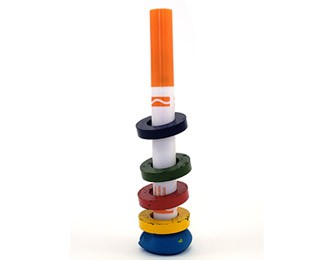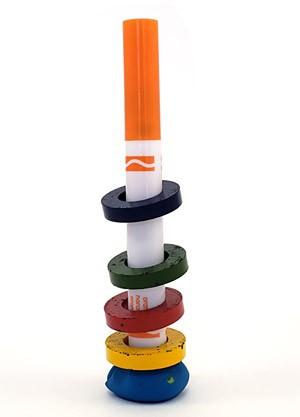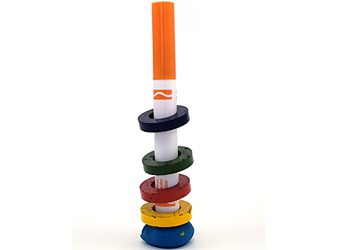Abstract
Have you ever seen a magician float an object in the air? If so, you might think that levitation (making things float) is just a magic trick, but the truth is you can use an invisible physical force to levitate a magnet! Try this science project to find out how.Summary
Sonali Mukherjee, Seagate
Edited by Sandra Slutz, PhD, Science Buddies
Special thanks to Dr. Luc Berger at Carnegie Mellon University for his help and insights.
- Play-Doh® is a registered trademark of Hasbro, Inc.
 Image Credit: Ben Finio, Science Buddies / Science Buddies
Image Credit: Ben Finio, Science Buddies / Science Buddies
Objective
In this science project you'll discover how to place magnets so they either attract or repel one another and then use that information to levitate a magnet.
Introduction
Imagine people's surprise when they came across the first magnet! It must have seemed like a magic stone to them—able to make tiny pieces of iron rise up and slide around by some invisible force. The earliest records of magnets are from the Chinese and the Greeks who both wrote of lodestones, which are naturally occurring stones that attract iron. Today we know that lodestones contain magnetite, a naturally occurring magnetic material. Through experimentation and observation, both the Chinese and the Greeks eventually began to use these magnetic lodestones to make compasses to use for navigation at sea. But it took until the 1600's before major scientific understanding of magnets occurred. And scientists are still discovering more and more about magnetic principles today!
One of the most basic and important features of magnets is that when allowed to rotate freely on a piece of string, they always align themselves so that one end faces the North Pole and the other end faces the South Pole, these two ends are referred to as the north and south poles of the magnet. By aligning the poles of two magnets in different combinations, the magnets will either be attracted, (pulled closer to one another) or repelled (pushed farther apart from one another). To learn more about magnets, check out the Science Buddies Electricity, Magnetism, & Electromagnetism Tutorial.
Magnets are used in a wide variety of household objects, including headphones, televisions, computer disks, and refrigerator magnets. Recently, engineers have used magnets to create maglev (short for magnetic levitation) trains. These maglev trains use the attractive and repellant nature of magnets to levitate or "float" above the tracks, rather than use wheels. The first commercial high-speed maglev train, located in Shanghai, China, began transporting people in December of 2003. It averages 250 miles per hour!
In this science project you'll conduct two experiments. In the first experiment you'll discover how to place two magnets in order to create a repellant force and an attractive force. Then you'll use that information in a second experiment to make your own magnetic levitation system.
 Image Credit: Alex Needham posted on Wikipedia / Public domain
Image Credit: Alex Needham posted on Wikipedia / Public domain
Figure 1. This maglev train in Shanghai, China uses magnets to levitate above the tracks and travels an average of 250 miles per hour!
Terms and Concepts
- Magnet
- Force
- North pole
- South pole
- Attract
- Repel
- Maglev train
- Levitation
Questions
- What do magnets do?
- How are magnets used in everyday life?
Bibliography
This website contain general information about magnets and what they are used for.
- Magcraft. (n.d.). Magnet Basics. Retrieved May 20, 2008.
- Bonsor, K. (2000, October 13). How Maglev Trains Work. Retrieved May 20, 2008.
Materials and Equipment
- Bar magnet with north and south poles labeled (2); these can be ordered online from Home Science Tools.
- Ring magnets (2); sets of ring magnets can be ordered online from Home Science Tools.
- Permanent marker
- Thick marker or crayon
- Spool of thread, Play-Doh®, or some other object that can be used as a stand for holding the marker or crayon upright.
- Lab notebook
Disclaimer: Science Buddies participates in affiliate programs with Home Science Tools, Amazon.com, Carolina Biological, and Jameco Electronics. Proceeds from the affiliate programs help support Science Buddies, a 501(c)(3) public charity, and keep our resources free for everyone. Our top priority is student learning. If you have any comments (positive or negative) related to purchases you've made for science projects from recommendations on our site, please let us know. Write to us at scibuddy@sciencebuddies.org.
Experimental Procedure
Remember to be careful when using the magnets so you don't get your fingers pinched between two magnets that are attracted to one another.
Determining Which Poles Attract and Repel One Another
- Place the two bar magnets on a table. Examine both ends of the bar magnets, you'll notice that one end of each magnet is labeled "north" or "N," and the other end is labeled "south" or "S." Bring the north pole of the first magnet close to the north pole of the second magnet. Do the two north poles attract or repel? Make a data table, like the one below, in your lab notebook and record your observations.
-
Using the same technique, try all the different combinations of poles and record your observations in your data table.
Pole Type of 1st Magnet Pole Type of 2nd Magnet Attract or Repel North North North South South North South South
- Look at your data table. What conclusions can you make? Do like (which also means the same) poles attract or repel? What about opposite poles?
Levitating a Ring Magnet
-
From your experiments with the bar magnets, you now know how the poles of two magnets behave when you bring them close to one another. Use that information to determine which is the north pole and which is the south pole for your ring magnets.
- Bring the flat side of one of the ring magnets close to the north pole of a bar magnet. Is the ring magnet attracted to or repelled from the bar magnet? Based on that observation, is the side of the ring magnet you chose the north or south pole? Using the permanent marker, label that side either "N" for north or "S" for south. Be careful not to get the ink on anything else, it'll stain!
- Repeat these steps in order to label the north and south poles of the second ring magnet.
-
Once you have the north and south poles of two ring magnets labeled, you are ready to determine the conditions under which you can achieve magnetic levitation.
-
First you need to make the holder for the ring magnets.
- Place the marker/crayon in the hole of the spool of thread, or in a lump of Play-Doh, so that it stands up vertically.
- Slide one ring magnet onto the marker/crayon, with the north pole facing the ceiling. It will fall to the base of the holder.
- Slide the second ring magnet onto the marker/crayon so that the north pole of the second magnet faces the north pole of the first magnet. What happens? Does the second magnet levitate? Record your observations in a data table, like the one below, in your lab notebook.
- Remove the ring magnets from the stand and repeat steps 5b and 5c using all the possible combinations for north and south poles of both magnets. Record your observations in your data table.
Pole Type of 1st Magnet Pole Type of 2nd Magnet Levitation of 2nd Magnet (Yes or No) North North North South South North South South
-
First you need to make the holder for the ring magnets.
- Look at your data table. Under which conditions does the second magnet levitate? Are the conditions for levitation the same as the conditions that caused the bar magnets to be attracted or repelled?
- Using what you have learned, can you get multiple magnets to levitate above each other, as shown in Figure 2?
 Image Credit: Ben Finio, Science Buddies / Science Buddies
Image Credit: Ben Finio, Science Buddies / Science Buddies
Figure 2. Three magnets floating above the bottom magnet.
Ask an Expert
Global Connections
The United Nations Sustainable Development Goals (UNSDGs) are a blueprint to achieve a better and more sustainable future for all.
Variations
Magnets are fascinating and have endless properties to explore. Here are a couple more ideas you can investigate with your magnets.
- Can you use a magnetic compass to determine which end of a magnet is the north pole and which is the south pole? Design an experiment to find out. Hint: Use the bar magnets, which already have their poles labeled, so you can interpret your observations.
- Did you know that you can make a temporary magnet out of a nail? Using a bar magnet, stroke the nail 30 times, in the same direction each time. Now can you use the nail to pick up staples? How many? What happens if you stroke the nail more times? Does it become a stronger magnet? Use the staples to find out.
Careers
If you like this project, you might enjoy exploring these related careers:










